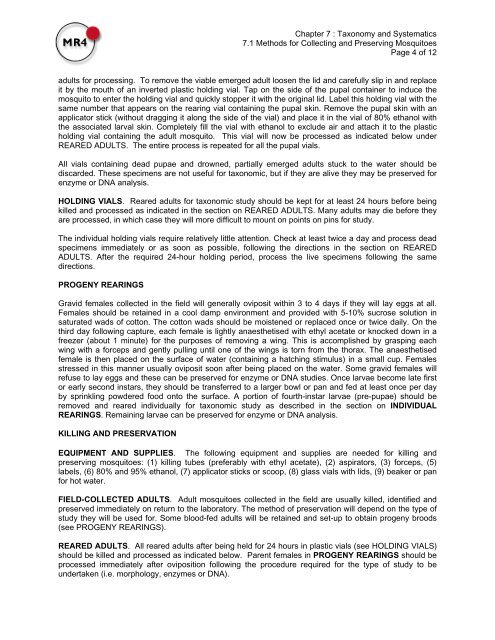Methods in Anopheles Research - MR4
Methods in Anopheles Research - MR4
Methods in Anopheles Research - MR4
- No tags were found...
You also want an ePaper? Increase the reach of your titles
YUMPU automatically turns print PDFs into web optimized ePapers that Google loves.
Chapter 7 : Taxonomy and Systematics7.1 <strong>Methods</strong> for Collect<strong>in</strong>g and Preserv<strong>in</strong>g MosquitoesPage 4 of 12adults for process<strong>in</strong>g. To remove the viable emerged adult loosen the lid and carefully slip <strong>in</strong> and replaceit by the mouth of an <strong>in</strong>verted plastic hold<strong>in</strong>g vial. Tap on the side of the pupal conta<strong>in</strong>er to <strong>in</strong>duce themosquito to enter the hold<strong>in</strong>g vial and quickly stopper it with the orig<strong>in</strong>al lid. Label this hold<strong>in</strong>g vial with thesame number that appears on the rear<strong>in</strong>g vial conta<strong>in</strong><strong>in</strong>g the pupal sk<strong>in</strong>. Remove the pupal sk<strong>in</strong> with anapplicator stick (without dragg<strong>in</strong>g it along the side of the vial) and place it <strong>in</strong> the vial of 80% ethanol withthe associated larval sk<strong>in</strong>. Completely fill the vial with ethanol to exclude air and attach it to the plastichold<strong>in</strong>g vial conta<strong>in</strong><strong>in</strong>g the adult mosquito. This vial will now be processed as <strong>in</strong>dicated below underREARED ADULTS. The entire process is repeated for all the pupal vials.All vials conta<strong>in</strong><strong>in</strong>g dead pupae and drowned, partially emerged adults stuck to the water should bediscarded. These specimens are not useful for taxonomic, but if they are alive they may be preserved forenzyme or DNA analysis.HOLDING VIALS. Reared adults for taxonomic study should be kept for at least 24 hours before be<strong>in</strong>gkilled and processed as <strong>in</strong>dicated <strong>in</strong> the section on REARED ADULTS. Many adults may die before theyare processed, <strong>in</strong> which case they will more difficult to mount on po<strong>in</strong>ts on p<strong>in</strong>s for study.The <strong>in</strong>dividual hold<strong>in</strong>g vials require relatively little attention. Check at least twice a day and process deadspecimens immediately or as soon as possible, follow<strong>in</strong>g the directions <strong>in</strong> the section on REAREDADULTS. After the required 24-hour hold<strong>in</strong>g period, process the live specimens follow<strong>in</strong>g the samedirections.PROGENY REARINGSGravid females collected <strong>in</strong> the field will generally oviposit with<strong>in</strong> 3 to 4 days if they will lay eggs at all.Females should be reta<strong>in</strong>ed <strong>in</strong> a cool damp environment and provided with 5-10% sucrose solution <strong>in</strong>saturated wads of cotton. The cotton wads should be moistened or replaced once or twice daily. On thethird day follow<strong>in</strong>g capture, each female is lightly anaesthetised with ethyl acetate or knocked down <strong>in</strong> afreezer (about 1 m<strong>in</strong>ute) for the purposes of remov<strong>in</strong>g a w<strong>in</strong>g. This is accomplished by grasp<strong>in</strong>g eachw<strong>in</strong>g with a forceps and gently pull<strong>in</strong>g until one of the w<strong>in</strong>gs is torn from the thorax. The anaesthetisedfemale is then placed on the surface of water (conta<strong>in</strong><strong>in</strong>g a hatch<strong>in</strong>g stimulus) <strong>in</strong> a small cup. Femalesstressed <strong>in</strong> this manner usually oviposit soon after be<strong>in</strong>g placed on the water. Some gravid females willrefuse to lay eggs and these can be preserved for enzyme or DNA studies. Once larvae become late firstor early second <strong>in</strong>stars, they should be transferred to a larger bowl or pan and fed at least once per dayby spr<strong>in</strong>kl<strong>in</strong>g powdered food onto the surface. A portion of fourth-<strong>in</strong>star larvae (pre-pupae) should beremoved and reared <strong>in</strong>dividually for taxonomic study as described <strong>in</strong> the section on INDIVIDUALREARINGS. Rema<strong>in</strong><strong>in</strong>g larvae can be preserved for enzyme or DNA analysis.KILLING AND PRESERVATIONEQUIPMENT AND SUPPLIES. The follow<strong>in</strong>g equipment and supplies are needed for kill<strong>in</strong>g andpreserv<strong>in</strong>g mosquitoes: (1) kill<strong>in</strong>g tubes (preferably with ethyl acetate), (2) aspirators, (3) forceps, (5)labels, (6) 80% and 95% ethanol, (7) applicator sticks or scoop, (8) glass vials with lids, (9) beaker or panfor hot water.FIELD-COLLECTED ADULTS. Adult mosquitoes collected <strong>in</strong> the field are usually killed, identified andpreserved immediately on return to the laboratory. The method of preservation will depend on the type ofstudy they will be used for. Some blood-fed adults will be reta<strong>in</strong>ed and set-up to obta<strong>in</strong> progeny broods(see PROGENY REARINGS).REARED ADULTS. All reared adults after be<strong>in</strong>g held for 24 hours <strong>in</strong> plastic vials (see HOLDING VIALS)should be killed and processed as <strong>in</strong>dicated below. Parent females <strong>in</strong> PROGENY REARINGS should beprocessed immediately after oviposition follow<strong>in</strong>g the procedure required for the type of study to beundertaken (i.e. morphology, enzymes or DNA).
















